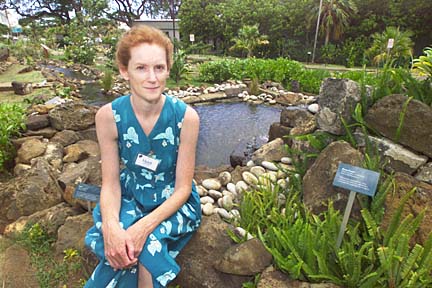


In The Garden![]()
Friday, June 22, 2001

DENINIS ODA / DODA@STARBULLETIN.COM
Heidi Lennstrom is in Bishop Museum's Science Garden
containing native Hawaiian plants that visitors can touch.
The Science Garden at Bishop Museum is a "touch garden" where visitors are welcome to handle the flowers and pinch the leaves for an up-close experience with native Hawaii plants. New garden offers
slice of old HawaiiSo far the people-friendly policy hasn't been a problem. Visitors have been gentle and respectful since the garden opened quietly in April. But not much in the young garden is ready for harvest yet.
A noni tree is bushy and healthy but has not produced mature fruits, which enjoy cult status as cures for many modern ills. A bed of 'uala, or sweet potato, is thriving, but the starchy tubers are hidden safely beneath the soil.
"I guess the real test will come when the plants get big enough," says paleoethnobotanist Heidi Lennstrom, project manager of the garden. "We don't mind if people touch the plants, but we don't want them to be walking away with anything."
The garden has been in the museum's education plans for many years and broke grounds in April last year, Lennstrom said. Even without much publicity, the 8,000-square-foot garden on the museum lawn has become a popular attraction.
The sound of cool running water in the garden's lo'i system attracts a constant flow of tourists who wander by to get a closer look. Hawaii school children are regular visitors who come for education programs about Hawaiian culture and science.
Local residents can take advantage of discounted admissions this Family Sunday to see the garden.
The garden has about 50 different plants that were brought by the first Polynesian settlers or already growing in the islands when they arrived. Each plant is accompanied by written text explaining its uses, and there are additional panels throughout the garden explaining Hawaii culture.
The brief and easy-to-read labels make self-guided tours a breeze. Plan to spend at least 30 minutes, longer if you have children. The nearby pavilion, with tables and chair, offers a cool resting spot for an overall view of the garden.
The plants are limited to those suited for the lowland areas because of the museum's Kalihi location, Lennstrom said. Koa trees, for example, were important to the Hawaiians for canoe building but do not grow well in Kalihi, and therefore are not included in the garden. (There is a koa tree on the museum grounds, but it is not a prime example.)
In time, more plants will be added to the garden, Lennstrom said, and she hopes to eventually build more gardens focusing on forest and beach plants.
"We chose plants that would grow naturally in this location. One of our intentions is to show people what a garden in this location would have been like," Lennstrom said.
Taro patches once dominated Kalihi, and the garden has two taro patches in its lo'i system. One has taro near maturity and the other one is being mulched. A small school of goldfish is kept in the lo'i to keep the water clean, and more aquatic animals may be added later to demonstrate ancient Hawaiian practices.
Some of the plants in the garden are common sights in Hawaii's landscape, such as ti leaves, hau trees, hala, sugar cane and the native white hibiscus, koki'o ke'oke'o. But some plants are not so common: koki'o 'ula, a rare orange-red hibiscus; or pili, twisted beardgrass, that the Hawaiians used as thatching material for houses.
Family Sunday Island Style at Bishop Museum
Place: 1525 Bernice St.
Time: 9 a.m. to 5 p.m. Sunday
Cost: $3 per person for military and residents or $10 for family of four. Free to museum members and children under 4
Call: 847-3511
Also: Education programs for school children are $3 per child. Call 848-4168 for information.
Here are some of the less common plants you'll find in the garden:
>> Wauke (paper mulberry). This plant is native to Asia and widely cultivated for its fiber. It was brought to the islands by the first Polynesian settlers, and was favored by the ancient Hawaiians for kapa making.
>> Popolo (glossy nightshade). The berries and greens of this plant were part of the traditional Hawaiian diet. The berries also were used to produce a blackish purple dye. The leaves were used for a general tonic and also for treatment of bloating, coughs, inflamed eyes and wounds.
>> Ma'o (Hawaiian cotton). This coastal hibiscus relative is endemic to Hawaii and was not used to make cloth. Instead it was cultivated for the yellow flowers that provided green and yellow dyes for kapa. In modern times, this plant is useful in producing more disease-resistant hybrid cotton plants.
>> Makaloa (Cyperus laevigatus). The leaves of this indigenous wetland sedge were used to make the finely plaited mats associated with the island of Niihau. The base of the plant was used to treat urinary problems.
>> Kohekohe (Eleocharis calva). The Hawaiians cultivated this wetland sedge for the dark sheaths at the bases of the leaves, which were used to create the dark geometric patterns on makaloa mats.
>> 'Akoko (Chamaesyce species). The Hawaiians referred to this endemic plant as "blood colored" for the color of its capsules. This plant was a favorite fuel for fires, and the milky sap was useful as canoe paint.
>> 'Ahu'awa (Cyperus javanicus). Stems from this wetland plant are pounded and dried to create strainers for the narcotic drink 'awa. The tough blades also were made into coarse cordage for house construction.
Gardening Calendar
Suzanne Tswei's gardening column runs Saturdays in Today.
You can write her at the Star-Bulletin,
500 Ala Moana, Suite 7-210, Honolulu, HI, 96813
or email stswei@starbulletin.comE-mail to Features Editor
Text Site Directory:
[News] [Business] [Features] [Sports] [Editorial] [Do It Electric!]
[Classified Ads] [Search] [Subscribe] [Info] [Letter to Editor]
[Feedback]
© 2001 Honolulu Star-Bulletin
https://archives.starbulletin.com